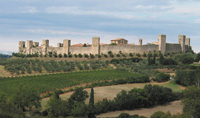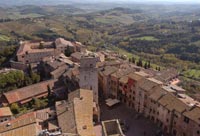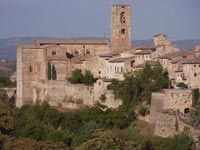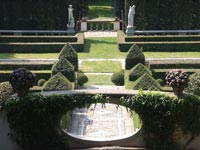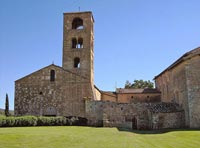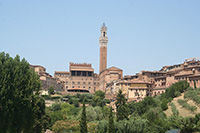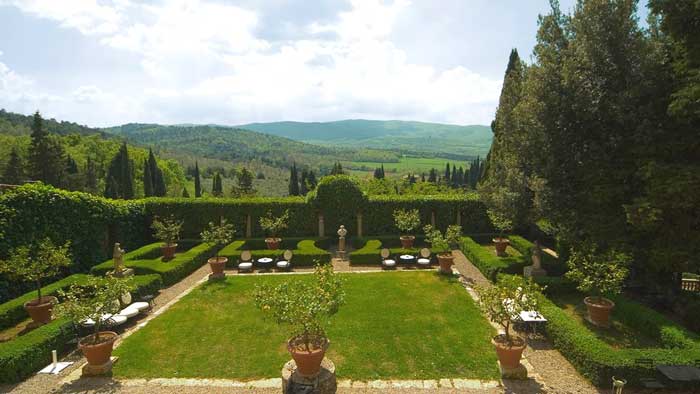 |
Villa La Suvera in Casole d'Elsa |
Villa La Suverana in Casole d'Elsa |
Villa La Suverana is situated in Maggiano, a frazione of Casole d'Elsa. The term suvera is a corruption of the French noun souveraine, or sovereign. The first records of the building date back to 1138, when it was the property of the powerful Longobard family, the Ardengheschi. In the mid-16th century, Pope Julius II (Giuliano della Rovere) received the villa as a gift from Pandolfo Petrucci, lord of the Republic of Siena. The pope ordered that what was then an austere fortress be transformed into a splendid Renaissance villa, surrounded by a large park, and the famous Sienese architectect Baldassarre Peruzzi was commissioned to carry out the plan. After Niccolò della Rovere, nephew of Julius II, the villa became the property of the Chigi family of Siena then changed hands several times again and was eventually bought by the present owners, the Ricci marquises, who have now turned it into a five-star country hotel. The grounds have several interesting features: a large courtyard to the north, with a fine 18th-century ironwork aviary at its centre; an Italian-style garden adorned with potted lemon trees; and another garden to the south with a lily pool; a wood of holm-oaks crossed by winding paths is also part of the estate. |
| History
The origins of La Suvera go back to the High Middle Ages as the Castle of the County of Siena ruled by the legendary Countess Ava Matilde dé Franzesi, a relation of the King of France Clovis, also known as the Queen of Montemaggio. It is therefore likely that the ancient name La Suvera derives from the French "Souveraine", meaning Sovereign. This county reached the peak of its glory under the rule of the powerful Ardengheschi family, Longobards, descendents of Ardengo, Charlemagne's Palatine Count. Later La Suvera passed into the hands of others in episodes of alternate good fortune and ill luck but finishing with the Republic of Siena gifting it to Pope Julius II, who wished to win the Pope's favour. This Renaissance Pope, a highly political and militant ruler, is far better known as Raffaello's patron who commissioned rooms in the Vatican, and Michelangelo's for the Sistine Chapel, and for having commissioned Bramante to build the new Basilica of St. Peter's. He entrusted La Suvera to the genius of Baldassarre Peruzzi, who blended the medieval severity of the medieval fortress with the sumptuous luxury of the Renaissance to create the villa as we know it today. La Suvera passed through inheritance to Pope Julius' nephew Niccolò della Rovere and from there it went to the Chigi family from Siena and later, through marriage, inheritance and acquisition it came into the current owners' hands, the family of the Marquis Ricci, who had in fact owned it before, as a deed of the Notary records of Siena testifies, as long ago as 1123. Marquis Giuseppe Ricci Paracciani and his wife Princess Eleonora Massimo have turned their home into an extraordinary five star country hotel for guests seeking true culture. They have combined the stories of the historical site with stories of their own well known ancestors, relics of whom furnish the suites and rooms which have been created for the utmost pleasure of their guests and in order to satisfy their natural curiosity. The Papal Villa today is the heart of a borgo which has developed over the centuries, with a consecrated church dedicated to Saint Carlo Borromeo in the 1400's with interiors that reflect 18th century tastes. A few later buildings complete the complex which is surrounded by a park with Italian formal gardens dating back to the 18th century. |
| Villa San Chimento |
||
This villa, built in the late 16th century by the Accarigi family, is an imposing two-storey building with a fine portico at the centre of the main front, in front of which is a terrace which is reached by a broad polygonal flight of steps. Adjoining the building is an attractive Italian-style garden, set out with circular flower-beds edged with box hedges and crossed by a winding path. Inside the property is an ancient oil press that is still in use. |
||
|
||
Monterriggioni |
San Gimignano, view from Rocca di Montestaffoli |
Colle di Val d'Elsa |
||
|
||||
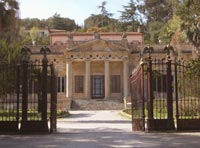 |
||||
Podere Santa Pia |
Podere Santa Pia, view from the garden on the valley below |
Villa San Martino, Napoleon’s summer residence | ||
Villa I Tatti |
Sovicille, Pieve di San Giovanni Battistaa Ponte allo Spino |
|||
|
||||

